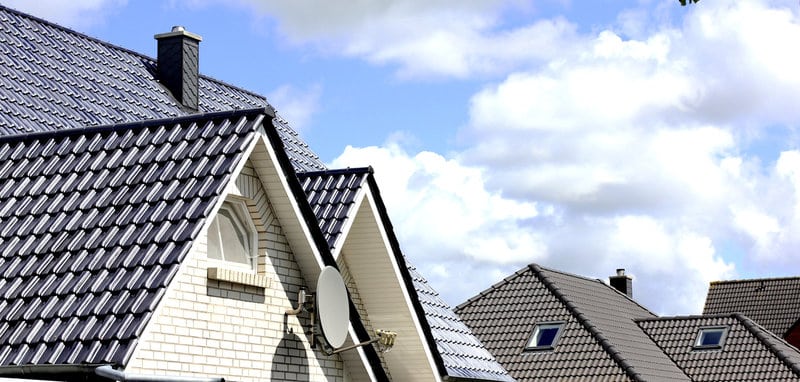
Are you trying to decide which type of roof is best for your home?
Whether you’re renovating your home or building a new one, adding a new roof is a major decision.
When it comes to installing a new roof, choosing the right style for your home is a significant decision. Factors such as aesthetics, climate, durability, and price all need to be taken into consideration.
If you’re deciding on the pros and cons of different roofing styles, you’re going to want to ensure that you know what each style offers.
8 Roofing Styles That You Have To Choose
Gable Roof
A gable roof is easily recognized by its triangular shape. It’s arguably the most popular roof style for American residential homes.
One of the best pros associated with a gable roof is the ability to easily rid of snow and water. This is due to its triangular shape and helps to take heavy pressure off of the roof. Another benefit with the gable roof is the ability to provide more space for the attic or vaulted ceilings.
While a gable roof is a relatively simple build and easy on the wallet, it’s not for every locale. This type of roof is best avoided in high wind or hurricane-prone areas. This is due to the fact that this type of roof can collapse if not constructed perfectly well.
If this type of roof is used in a high-wind area, be sure to have the proper braces fastened. You will also want to have the roof inspected after any major storms.
Flat Roof
As the name suggests, a flat roof is characterized by a seemingly flat surface.
While to roof appears perfectly flat, there is a slight pitch that is not visible to the eye. This helps to encourage rain and snow run-off and prevent buildup.
More often than not, a flat roof is used in commercial or industrial buildings. However, they can also be used with residential homes.
Keep in mind that areas with high amounts of precipitation may want to opt for a roof with a more significant pitch. The risk of the roof caving due to pressure is an obvious disadvantage of the flat roof.
However, there are many significant benefits of the flat roof. The first being the ability to easily install solar panels without having them visible and the second being the potential for a terrace and green space.
Skillion Roof
A skillion roof is also known as a shed roof or a lean-to roof.
This roof is a single, sloping roof that is attached to a higher wall. Think of a flat roof that is slightly angled.
We often see this type of roof on a cabin, shed or even additions to a home. A new growing trend for the skillion roof is now being seen in modern homes. This roof results in a more minimal look and can be very visually appealing.
It’s also relatively inexpensive and requires fewer materials than a more traditional roof. It also makes for easy installation for solar panels!
Butterfly Roof
A butterfly roof is a slightly V-shaped roof that is constructed of two tandem pieces. These two pieces are angled downward at the midsection which is where the V-shape comes from.
The most common reason one might opt for a butterfly roof would be to make room for windows directly beneath the roof. This helps to allow more natural light into the home.
This type of roof is common in modern homes, energy efficient homes and tropical home designs.
The most obvious con for the butterfly roof would be the high cost. Because this is a non-traditional and very visually appealing roof, initial construction costs are high as well as maintenance. This is also due to the fact that the roof can be prone to leakage.
Hip Roof
A hip roof has slopes on all four sides of the roof.
Again, this is a more common roof in terms of residential housing and is even more stable than the gable roof.
This type of roof is the ideal choice in terms of durability. They perform well in high wind areas as well as areas with plentiful precipitation.
They can also add extra space for the home with the addition of dormers. Dormers can help to add extra space and allow more natural sunlight into the home.
Unfortunately, hip roofs are more expensive than the standard gable roof. This is because it’s a more complex design and requires more building materials.
Gambrel Roof
A gambrel roof is most often seen on country homes or barns. However, they are also common with Georgian and Colonial style homes.
This type of roof benefits from two different slopes. The lower side of the gambrel roof has a vertical and steep slope. The upper slope is lower and less obvious. This provides the roof with more visual appeal and also helps to eliminate precipitation buildup.
This style roof allows for extra living space in terms of an attic or loft. Windows can even be added to the roof to allow for more light. However, as with any window, this can allow for a higher risk of leakage.
Saltbox Roof
A saltbox roof is asymmetrical in design in that one side of the roof has a larger slope than the other. The front of the home often has a more steep slope whereas the rear of the home has a less steep slope.
It can add extra living space by making a home one and a half to two stories. It also means that some rooms will benefit from the allure of slanted ceilings.
Unfortunately, this is not always a straightforward design. This means it’s less friendly to the wallet and can make for a tough renovation project.
Curved Roof
If you’re looking for the most non-traditional and unique style roof, you may want to consider opting for a curved roof.
The amount of curve can vary from a slight curve to an arch shape. This is common in more unique homes and even commercial galleries. This type of roof also provides for unique interior shaping.
While the price is expensive, it’s worthwhile to consider that the entire roof of the structure does not need to be curved. A good example of this would be a curved front entrance.
The best material for a curved roof would be metal. This ensures that it is durable and aesthetically pleasing. A metal roof typically has a lifespan between 30 and 50 years.
Time To Decide Which Roofing Styles Are Best For You!
Are you feeling intimidated by all the choices when it comes to roofing styles?
With such a wide selection, it’s tough to decide which roof is best for your particular home.
Fortunately, we’ve done the work for you and selected the eight best roof styles in general. From here, we’ve outlined the pros and cons of each style to help you decide which roof best suits your needs.
When it comes to choosing your roof, be sure to take into account your local weather patterns, aesthetic and which option best suits your bank account.
You’ll also want to ensure that you choose the highest quality roof professionals available. This ensures that the roof is of good quality from the start and helps to avoid higher maintenance issues and costs.
Check out our blog for more roofing tips!

